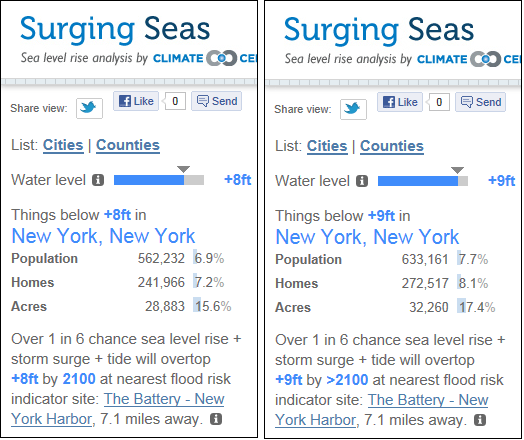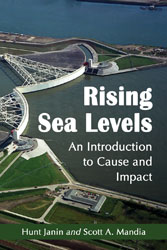71,000 New Yorkers: “Rise Does Matter!”
Superstorm Sandy produced record storm surge levels for locations in and around the NY City metropolitan region. One way that global warming made Sandy worse is because global warming is causing sea levels to rise. Sea levels have risen more than a foot in the New York City region since the Industrial Revolution. So what difference did this extra foot make for the citizens of New York City? Quite a lot. 6,000 more people impacted for each inch of rise!
70,929 more people and 30,551 more homes flooded.

8ft surge vs. 9 ft surge for New York City residents
I asked storm surge expert Dr. Ben Strauss to reflect on what this extra foot meant for New Yorkers. His reply appears below (with permission):
According to NOAA’s preliminary tide gauge readings, Sandy peaked at 9.15 ft above Mean High Water (MHW, the average high tide line) at The Battery in NYC. Surging Seas uses the same elevation reference, MHW. So from our tool you can see we estimate that in NYC alone, ~633k people live on, and ~273k homes sit on, land that’s less than 9 ft above MHW. Compare that to 8ft, or one foot less: ~562k people and ~242k homes. So, yes, Sandy’s damage would absolutely still have been unthinkable without the extra 8 inches or so we might attribute to warming since the late 19th century. But you add about 6k people per vertical inch in this 8-9 ft elevation range. I think we all would have been happy to see just a few percent less damage here!
A few other thoughts:
- flood damage increases more steeply than flood depth
- how many pieces of infrastructure might have been saved if the water were a bit lower?
- a relative of mine heard a CBS news radio report that the water got 1.5 ft higher than anyone at Con Ed had ever imagined/planned for — I don’t know the exact wording. Would the 14th St transformer station that exploded and left so much of lower Manhattan in the dark — would it have exploded with 8 inches lower water? (est. global sea level rise since 1880) 15 inches? (est total NYC SLR since 1880, including local land subsidence)
Sea level rise is certainly not the main story line here, but it contributed to the total damage from flooding and surge without any doubt. Furthermore, Sandy provides an illustration of flood levels that could be common — say, once a decade or worse toward the end of this century — if the upper end of sea level rise projections for NYC are realized.
Dr. Ben Strauss serves as Chief Operating Officer and Director of the Program on Sea Level Rise at Climate Central. In the latter capacity, he has published multiple scientific papers, testified before the U.S. Senate, authored the Surging Seas report, and led development of the SurgingSeas.org coastal flood risk tool, leading to front-page coverage in the New York Times and Washington Post, appearances on NBC, ABC, CBS, PBS and NPR national programming, and extensive coverage nationwide, from AP, Reuters, Bloomberg, USA Today and the LA Times, to many hundreds of local news outlets, to numerous editorials and op eds.
In the future, we will look back at the one foot sea level rise as “the good old days”. According to the New York State Sea Level Rise Task Force Report, it is very possible that seas will rise an additional 2.5 ft by the 2050s and 4.5 ft by the 2080s. Imagine what a Sandy would do then? It is pretty clear that New York City planners have much work to do to avoid future catastrophes. City officials did not endorse many of the recommendations of the Task Force in 2010. Perhaps they will reconsider their position now?


I notice that there has been talk of building sea defences to protect from future sea surges: much as London has done. The problem with levees or barriers is that they can give a false sense of security. Without them people will evacuate. With them, people tend to stay put — especially if they’re reassured by the authorities that they’re safe.
So with barriers they might be OK for the next 20/30/40/50 years, and complacency will set in. Then, as sea level rises further, it will reach a point, suddenly, when the defences are over-topped and give way. Because of sudden failure, the resultant disaster is then that much worse.
This was the situation in Japan where the 40foot high barriers on some coastal towns led to people feeling safe; until, that is, a once in a thousand year event occurred. Nearer to home we should remember it was the failure of levees that resulted in most of the deaths at New Orleans, not Katrina.
So to sum up, sea defences are good; until they fail.
John Russell (@JohnRussell40)
November 5, 2012 at 8:13 am
Well stated. Pretty much what Hunt Janin and I say in our book on the subject. Sigh.
Scott Mandia
November 5, 2012 at 8:40 am
Good point, although being an “optimist,” I doubt that many people will be complacent about global warming in 40 years.
climatehawk1
November 5, 2012 at 4:50 pm
[…] eight inches matters a lot. First of all, using Climate Central’s Surging Seas tool, Mandia estimated that 6,000 more people were impacted for each additional inch of sea-level rise. That means, […]
Climate change made Sandy worse. Period. | Grist
November 8, 2012 at 3:30 pm
I did a simple calculation of this. 3,5mm/y*87,5years is about a foot. 87,5*365.25days=31959,375days. 71000 humans/31959,375days= about 2.22people/day. So to have no climate refugees in Sandy affected area in the future 87.5 years would mean that about 66 people should voluntarily move out of there every lunar month. Of course this does not take to account the possible increase in the rate of the rise of the mean sea level, and the possibility of increasing storm strenght as the moisture in the oceanic atmosphere inreases as is likely to happen with increasing temperatures.
jyyh
November 8, 2012 at 10:59 pm
[…] 2012/11/05: SMandia: 71,000 New Yorkers: “Rise Does Matter!” […]
Another Week of GW News, November 11, 2012 – A Few Things Ill Considered
November 12, 2012 at 1:37 pm
[…] https://profmandia.wordpress.com/2012/11/05/71000-new-yorkers-rise-does-matter/ […]
A Tale of Two Articles
November 12, 2012 at 10:56 pm
[…] a lot. First of all, using Climate Central’s Surging Seas tool, [climate scientist Scott] Mandia estimated that 6,000 more people were impacted for each additional inch of sea level rise. … “An inch […]
The whole truth about Superstorm Sandy and climate change – Washington Post (blog)
November 15, 2012 at 11:39 am
[…] a lot. First of all, using Climate Central’s Surging Seas tool, [climate scientist Scott] Mandia estimated that 6,000 more people were impacted for each additional inch of sea level rise. … “An inch […]
The whole truth about Superstorm Sandy and climate change | News from around the world
November 15, 2012 at 11:51 am
[…] […]
The Climate Change Debate Thread - Page 1766
November 15, 2012 at 4:01 pm
[…] And there’s a way to calculate the incremental impact of sea level rise, as described at Global Warming: Man or Myth: “Superstorm Sandy produced record storm surge levels for locations in and around the NY City […]
Record 60 F. on Thanksgiving (today will feel 50 degrees colder) || Conservation Minnesota
November 23, 2012 at 6:47 am
[…] eight inches matters a lot. First of all, using Climate Central’s Surging Seas tool, Mandia estimated that 6,000 more people were impacted for each additional inch of sea level rise. That means, […]
What Are The Measured Impacts Of Anthropogenic Climate Change To Date? | The Lukewarmer's Way
February 18, 2013 at 9:51 pm
We’re in the longest stretch without a major hurricane landfall on US soil since the 1860’s…
http://www.propertycasualty360.com/2013/01/24/us-in-longest-stretch-without-major-hurricane-land
“Climate change” has been very good to us.
Mike Mangan
May 5, 2013 at 3:24 pm
U.S. Sees Record-Low Tornadoes and Tornado Deaths!
“Climate change” has been very, very good to us.
Mike Mangan
May 5, 2013 at 3:27 pm
[…] And I have said again and again, it is not just scientists who are concerned about climate disruption. Military and intelligence experts warn that climate-induced crises could topple governments, feed terrorist movements or destabilize entire regions. Health officials warn us that climate change could be the biggest global health threat of the 21st century. Climate change was recently listed as the greatest strategic risk currently facing the property/casualty insurance industry. (And the extra sea level rise caused by humans made Hurricane Sandy much worse.) […]
Scientists’ Consensus on Maintaining Humanity’s Life Support Systems in the 21st Century | Global Warming: Man or Myth?
May 23, 2013 at 11:48 am
[…] The difference is that in sports the goalposts are stationary while climate deniers constantly move them to suit their motives. It appears that even the most ardent climate change deniers are accepting what virtually every publishing climate scientist knows and what every international academy of sciences knows: human activities, especially the burning of fossil fuels such as coal, oil, and natural gas, are causing the planet to warm. And of course, our eyes also tell us. Here in the US and also around the world, we are observing an increase in the frequency and severity of drought, heat waves, fires, and floods. We also see the increasing sea levels which played a significant role in Sandy’s devastation. […]
Goalposts are not just for sports: Climate deniers use them too! | Global Warming: Man or Myth?
September 16, 2013 at 5:45 am
[…] of seawater as it warms). And that matters: For every inch of sea level rise, an estimated 6,000 additional people were impacted by Sandy who wouldn’t have been otherwise. That’s why Strauss told me […]
4 Reasons You Should Worry About Another Sandy - GreenEnergy4.us
October 29, 2013 at 8:38 am
[…] of seawater as it warms). And that matters: For every inch of sea level rise, an estimated 6,000 additional people were impacted by Sandy who wouldn’t have been otherwise. That’s why Strauss told me […]
4 Reasons You Should Worry About Another Sandy
October 29, 2013 at 9:56 am
[…] of seawater as it warms). And that matters: For every inch of sea level rise, an estimated 6,000 additional people were impacted by Sandy who wouldn’t have been otherwise. That’s why Strauss told me […]
4 Reasons You Should Worry About Another Sandy | nuzreal.com
October 30, 2013 at 2:03 am
[…] of seawater as it warms). And that matters: For every inch of sea level rise, an estimated 6,000 additional people were impacted by Sandy who wouldn’t have been otherwise…” Photo credit above: […]
Light Rain Tonight; Drying Out For Halloween (lessons from Superstorm Sandy) || Conservation Minnesota
October 30, 2013 at 9:37 am
[…] of seawater as it warms). And that matters: For every inch of sea level rise, an estimated 6,000 additional people were impacted by Sandy who wouldn’t have been otherwise…” Photo credit above: […]
Light Rain Tonight; Drying Out For Halloween (lessons from Superstorm Sandy) || Conservation Minnesota
October 30, 2013 at 9:47 am
[…] of Physical Sciences at Suffolk County Community College on Long Island, New York, stated on his blog soon after the storm […]
Experiencing a taste of climate change is no ‘walk in the park.’ | Climate Change Comedian
July 30, 2016 at 10:53 pm
[…] Zunächst einmal mit Das Surging Seas-Tool von Climate Central, [climate scientist Scott] Mandia geschätzt dass 6.000 weitere Menschen für jeden weiteren Zentimeter des Anstiegs des Meeresspiegels […]
Der Klimawandel hat Superstorm Sandy nicht verursacht, aber wahrscheinlich seine Auswirkungen verstärkt – Letzte Neuigkeiten – Lesen Sie die Welt heute. – Byhil.com
May 19, 2021 at 1:47 pm